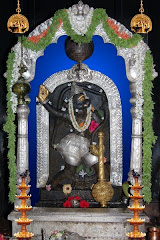
Jai Hanuman
Shri Hanuman Chalisa
Doha
Shri guru charan saraj raj, Nij manu mukur sudhare |
Barnau raghubar bimal jasu, Jo dhayak phal chare ||
Budhihien tanu jaanke, Sumerao pavan-kumar |
Bal budhi vidhya dehu mohe, Harhu kales bikar ||
Chopai
Jai hanuman gyan gun sagar |
Jai kapise tehu lok ujagar ||
Ram dut atulit bal dhama |
Anjani putra pavan sut nama ||
Mahabir bikram bajragee |
Kumati nivas sumati ke sangi ||
Kanchan baran biraj subesa |
Kann kundal kunchit kesa ||
Haat vajar ao dheja biraje |
Kandhe muj janeu sajee ||
Sankar suvan kesrinandan |
Tej pratap maha jag bandhan ||
Vidhyavan gune aati chatur |
Ram kaaj kaibe ko aatur ||
Prabhu charit sunibe ko rasiya |
Ram lakhan sita maan basiya ||
Susham roop dhari siyahi dhikhava |
Bikat roop dhari lank jarava ||
Bhim roop dhari asur sahare |
Ramchandra ke kaaj savare ||
Laye sanjeevan lakhan jiyaye |
Shriraghuvir harsha ure laye ||
Raghupati kinhe bahut badai |
Tum mam preye bharat sam bhai ||
Sahart badan tumarhu jas gavey |
Aas kahi shripati kant lagavey ||
Sankadeek bhramadhi munisa |
Narad sarad sahit ahisa ||
Jam kuber digpal jaha thi |
Kavi kovid kahi sake kaha thi ||
Tum upkar sughuv kehina |
Ram milaye raj pad denha ||
Tumraho mantra vibhekshan mana |
Lankeshvar bhaye sab jag jaan ||
Jug sahes jojan per bhanu |
Linyo tahi madhur phal janu ||
Prabhu mudrika meli mukh mahi |
Jaldhi ladhi gaye acraj nahi ||
Durgam kaaj jagat ke jete |
Sugam anugrah tumre tete ||
Ram duaare tum rakhvare |
Hoot na aagya binu pasare ||
Sab sukh lahai tumhre sarna |
Tum rchak kahu ko daarna ||
Aapan tej samharo aape |
Teno lok hakte kape ||
Bhut pesach nikat nahi aaveh |
Mahavir jab naam sunaveh ||
Nase rog hare sab peera |
Japat nirantar hanumat bal bira ||
Sankat se hanuman chudave |
Maan kam bachan dayan jo lavey ||
Sab per ram tapasvi raja |
Tin ke kaaj sakal tum saja ||
Aur manorat jo kayi lave |
Tasuye amit jeevan phal pavey ||
Charo guj pratap tumarah |
Hai prasidh jagat ujeyara ||
Sadhu sant ke tum rakhvare |
Asur nikandan ram dulare ||
Ashat sidhi navnidhi ke data |
As var deen jaanki mata ||
Ram rasayan tumhre pasa |
Sada raho raghupati ke dasa ||
Tumreh bhajan ram ko bhavey |
Janam janam ke dukh bisravey ||
Ant kaal raghubar pur jaie |
Jaha janam hari bhagat kahaei ||
Aur devta chitna dhareyo |
Hanumat seye sarav sukh karaei ||
Sankat kate mite sab pera |
Jo sumere hanumat balbira ||
Jai jai jai hanuman gusai |
Kripa karo guru dev ke naai ||
Jo sat bar pat kar koi |
Chutehi bandhi maha sukh hoai ||
Jo yahe pade hanuman chalisa |
Hoye sidhi sa ke goresa ||
Tulsidas sada hari chera |
Kijeye nath hridaye maha dera ||
source: Internet









